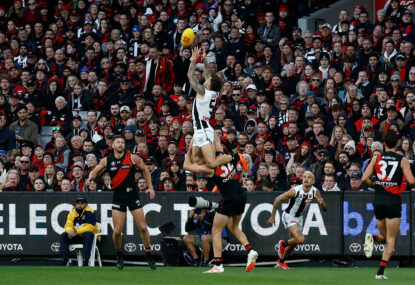Like most good theories, this one started over a couple of quiet beers.
Admittedly I should preface, this is a well-researched belief: that banners are not just important to the game of Aussie Rules but fundamentally essential to its survival.
I’ll argue my case shortly, but first allow me the opportunity to digress quickly to set the scene.
The seed of this hypothesis was planted on a Thursday night in December 2019, when I met a mate after work at the Annandale Hotel in Sydney’s inner west.
He’d texted a few nights prior with a proposal – of sorts – which we were meeting to discuss.
The message read:
“Random business idea for you. Write a book on the best footy banners of all time. Picture book with short interviews or comments from the banner writers. I’ll split royalties with you.”
I have always been predisposed to get-rich-quick schemes so my interest had been piqued immediately.
Case in point – my family home in Flagstaff Hill backed onto the driving range of a local golf course and I spent my afternoons as a kid scouring the thorned bushes and overgrown shrubs for loose balls abandoned by their former (wayward) owners.
Once my haul was collected I would clean and polish the merchandise in the kitchen sink before flogging them out the front of my house to other golfers making their way to the club.
“Golf balls – three for $5” my makeshift hand-written sign read, sticky taped loosely to the back of a wooden school ruler so it could be easier waved at cars.
In hindsight, it was actually a genius business model.
Turns out writing a book was a little more complicated and it hasn’t made us rich (yet) nor was the process quick.
I know this because 18 months after that quiet beer our book (co-written by my good friend Leigh Meyrick) was published and is now available in all major stores around the country.
It’s titled Footy Banners: A Complete Run-Through and celebrates one of the games longest-standing and most iconic traditions.
In a nutshell the book – which will most likely find its forever home on a coffee table somewhere – is a collection of photos, stories and historical analysis of arguably the quirkiest sporting ritual known to man.
We looked at everything from the funny to the offensive, the emotional to the political and, of course, the banner fails that are now unfortunately forever frozen in time.
Hours and hours of time and effort go into making these giant structures – some as high as 10m – just for them to come crashing down in a matter of seconds.

AFL club Western Bulldogs banner.
On face value, the practice makes absolutely no sense whatsoever. It’s a paradox in of itself – something so carefully and passionately created for the sole purpose of its own destruction. Actually kind of sadistic if you stop and think about it.
Banners started appearing in Victoria in the 1930s, although in a very different form to what we know today and from there, as they say, the rest is history.
As we write in the book:
Fans had found a new way of showing their support, attaching loose streamers to the end of the races.
The exhilarating moment when fans got their first glimpse of their heroes was now enhanced by a touch of pageantry.
From there, the decorating tradition developed quickly, causing the field umpire (there was only one per game until the 1970s) in charge of the 1939 Grand Final to crawl on his hands and knees to avoid disturbing the paper lattice.
The spread of run-through banners wasn’t confined to Victoria. In the same era, banners became commonplace in the state competitions based in Adelaide and Perth.
By the 1960s, clubs stopped dangling banners from the end of the race and supported them instead on poles, allowing cheer squads to set them up on the boundary line at a greater height.
Many regard the 1970s as the decade when Australia’s conservative culture was upended and things took a turn for the weird in the world of banners then, too.
From there, the banner movement only gained momentum. Through the eighties and nineties, banners became a talking point as cheer squads pushed the boundaries of banner design and community tolerance. Banners were now being created in all shapes and sizes.
The monstrous era we were about to enter would belie the banner’s humble beginnings.

So what went wrong? How could such a popular fan-led initiative now be fighting for its life in 2021?
Turns out there are actually quite a few reasons:
Firstly, commercialisation of the code didn’t help with banner messages becoming prime real estate for sponsors to hijack and corrupt.
Secondly, over-regulation from the league has limited the size and created rules due to occupational health and safety concerns.
Thirdly, club censorship controls the messaging and eradicates any potential for political incorrectness, embarrassment and fun.
Fourthly, a global pandemic has pretty much ruined everything. Banners being no exception. As crowds disappeared, so did the run-throughs.
So, here we are standing on the precipice of the unknown.
Banners have returned this year (for some clubs) but their existence in future seasons is precarious, to say the least.
But hold on (I hear you ask) – this article initially suggested the very opposite. In fact, it was strongly implied that banners are crucial to the future of the game to survive.
Well, now it’s time for my theory.
I’m certain you would have heard the phrase ‘death by a thousand cuts’?
It refers to a torturous execution method from China in the ninth century where poor souls were painfully dismembered as part of a slow process of small wounds that ultimately ended in, well, death.
If we’re not careful, footy will go the same way.
Removing some traditions from the game has already left fans disillusioned – the bump, the biff, the banner?
It might seem like a small thing – and every cut is – but it’s the accumulated toll that does the long-term damage.
Once the game becomes unrecognisable, it becomes redundant.
We don’t have many of these culturally unique quirks left so the ones that do remain need to be protected at all costs – the banner included.
So next time you’re at the footy, spare a thought for the person who wrote the prose, tip your hat to the cheer squad who built it with passion and have a chuckle at the player whose boot got caught in the tape. They are banners after all, they shouldn’t be taken too seriously.
By the way, if you want to learn more about banners, I just so happen to know the perfect book for you.
Footy Banners: A Complete Run-Through is available in all major stores or can be purchased online





































































































